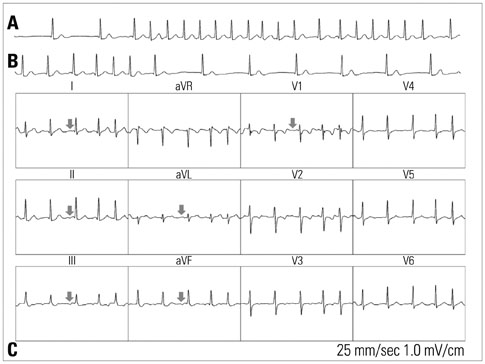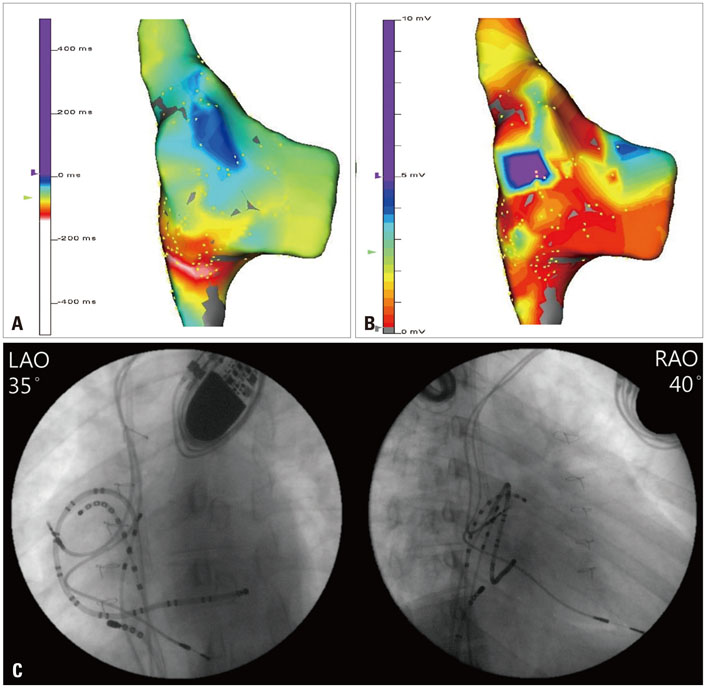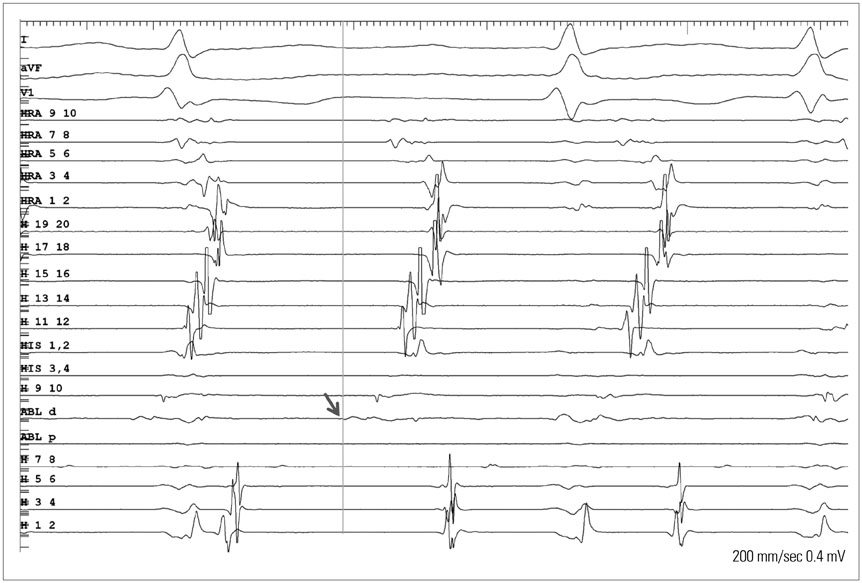Yonsei Med J.
2017 Jul;58(4):884-887. 10.3349/ymj.2017.58.4.884.
Focal Atrial Tachycardia Arising from the Inferior Vena Cava
- Affiliations
-
- 1Department of Cardiology, Yonsei University Health System, Seoul, Korea. hnpak@yuhs.ac
- KMID: 2419099
- DOI: http://doi.org/10.3349/ymj.2017.58.4.884
Abstract
- The inferior vena cava (IVC) is a rare site of focal atrial tachycardia (AT). Here, we report a 20-year-old woman who underwent catheter ablation for anti-arrhythmic drug-resistant AT originating from the IVC. She had undergone open-heart surgery for patch closure of an atrial septal defect 17 years previously and permanent pacemaker implantation for sinus node dysfunction 6 years previously. The AT focus was at the anterolateral aspect of the IVC-right atrial junction, and it was successfully ablated under three-dimensional electroanatomical-mapping guidance. We suspect that the mechanism of this tachycardia was associated with previous IVC cannulation for open-heart surgery.
MeSH Terms
Figure
Reference
-
1. de Groot NM, Zeppenfeld K, Wijffels MC, Chan WK, Blom NA, Van der Wall EE, et al. Ablation of focal atrial arrhythmia in patients with congenital heart defects after surgery: role of circumscribed areas with heterogeneous conduction. Heart Rhythm. 2006; 3:526–535.
Article2. Magnin-Poull I, De Chillou C, Miljoen H, Andronache M, Aliot E. Mechanisms of right atrial tachycardia occurring late after surgical closure of atrial septal defects. J Cardiovasc Electrophysiol. 2005; 16:681–687.
Article3. Lukac P, Pedersen AK, Mortensen PT, Jensen HK, Hjortdal V, Hansen PS. Ablation of atrial tachycardia after surgery for congenital and acquired heart disease using an electroanatomic mapping system: Which circuits to expect in which substrate? Heart Rhythm. 2005; 2:64–72.
Article4. Scavée C, Jaïs P, Weerasooriya R, Haïssaguerre M. The inferior vena cava: an exceptional source of atrial fibrillation. J Cardiovasc Electrophysiol. 2003; 14:659–662.5. Yamane T, Miyazaki H, Inada K, Matsuo S, Miyanaga S, Date T, et al. Focal source of atrial fibrillation arising from the ostium of the inferior vena cava. Circ J. 2005; 69:756–759.
Article6. Kato Y, Horigome H, Takahashi-Igari M, Aonuma K. Focal atrial tachycardia originating from inside the inferior vena cava late after surgical repair of congenital heart defects. Pediatr Cardiol. 2011; 32:846–848.
Article7. Higa S, Tai CT, Lin YJ, Liu TY, Lee PC, Huang JL, et al. Focal atrial tachycardia: new insight from noncontact mapping and catheter ablation. Circulation. 2004; 109:84–91.
Article8. Katsivas AG, Manolis AG, Vassilopoulos C, Ioanidis P, Giotopoulou A, Kyriakides Z. Electroanatomical mapping of a right atrial tachycardia originating within the inferior vena cava. Hellenic J Cardiol. 2004; 45:187–190.9. Murphy JG, Gersh BJ, McGoon MD, Mair DD, Porter CJ, Ilstrup DM, et al. Long-term outcome after surgical repair of isolated atrial septal defect. Follow-up at 27 to 32 years. N Engl J Med. 1990; 323:1645–1650.
Article10. Pap R, Kohári M, Makai A, Bencsik G, Traykov VB, Gallardo R, et al. Surgical technique and the mechanism of atrial tachycardia late after open heart surgery. J Interv Card Electrophysiol. 2012; 35:127–135.
Article
- Full Text Links
- Actions
-
Cited
- CITED
-
- Close
- Share
- Similar articles
-
- Transposition of inferior vena cava
- A case of hemiazygos continuation of a left inferior vena cava
- Leiomyosarcoma arising from the inferior vena cava: a case report
- Persistent Left Superior Vena Cava with Absent Right Superior Vena Cava and Large Atrial Septal Defect in Visceroatrial Situs solitus
- Obstruction of the Hepatic Portion of the Inferior Vena Cava




